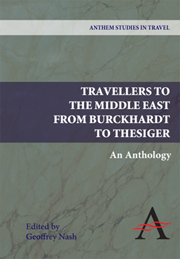Book contents
- Frontmatter
- Contents
- Acknowledgements
- Introduction
- PART ONE THE COMING OF EMPIRE 1800–1879
- PART TWO COLONIALISM AND RESISTANCE 1880–1950
- Ottoman and Former Ottoman Territories
- Arabia
- 1 ‘Some Excursions in Oman’
- 2 Revolt in the Desert
- 3 Ibn Sa'oud of Arabia: His People and His Land
- 4 The Southern Gates of Arabia
- 5 Arabia Felix
- 6 Arabian Sands
- Persia/Iran
- Bibliography
6 - Arabian Sands
from Arabia
Published online by Cambridge University Press: 05 March 2012
- Frontmatter
- Contents
- Acknowledgements
- Introduction
- PART ONE THE COMING OF EMPIRE 1800–1879
- PART TWO COLONIALISM AND RESISTANCE 1880–1950
- Ottoman and Former Ottoman Territories
- Arabia
- 1 ‘Some Excursions in Oman’
- 2 Revolt in the Desert
- 3 Ibn Sa'oud of Arabia: His People and His Land
- 4 The Southern Gates of Arabia
- 5 Arabia Felix
- 6 Arabian Sands
- Persia/Iran
- Bibliography
Summary
Described by Harry St. John Philby as ‘probably the greatest of all explorers’ Thesiger lived to see the traditional ways and the last unfilled spaces of the Middle East disappear. Born and until the age of eight brought up in Abyssinia where his father was consul-general and minister plenipotentiary, he imbibed from his earliest days the best traditions of the colonial service's dedication to service in foreign lands. After an undistinguished education at Eton and Oxford, he joined the Sudan political service in 1935. To his early exploration in Abyssinia was added several years trekking in the deserts of western Sudan and Libya. The Second World War campaign against the Italians brought him back to Abyssinia; he also saw service in Syria, North Africa and Palestine. But it was in the years immediately after the war that Thesiger embarked on his now celebrated journeys in Oman and the Empty Quarter. His first crossing took place in 1946–7, beginning and ending at Salalah on the coast of south-west Arabia. On this, the second crossing of 1947–8, as well as on further journeys in 1949 and 1950, Thesiger travelled with two Bedouin youths, Salim bin Kabina and Salim bin Ghabaisha. He wrote Arabian Sands, his narrative of these journeys a decade later. This and The Marsh Arabs (1964), the product of yearly visits to the marshes of southern Iraq until 1958, brought fame and acclamation.
- Type
- Chapter
- Information
- Travellers to the Middle EastAn Anthology, pp. 236 - 242Publisher: Anthem PressPrint publication year: 2009
- 5
- Cited by



